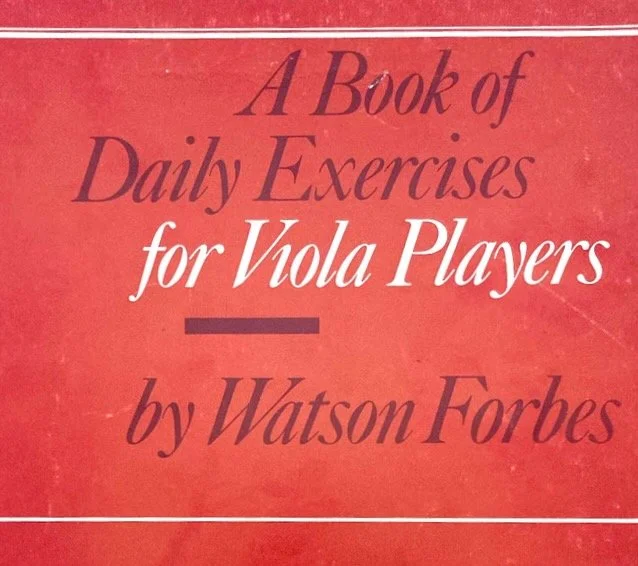Scale Up! Roger Benedict's new viola scale book
Roger Benedict
Confession: I own A LOT of scale books! This is surprising, considering as a student I would smile and nod when my teachers assigned me scales to practice, proceed to ignore the assignment for the rest of the week, then practice them for about five minutes immediately before my next lesson. I’m sure none of my teachers noticed! And I’m sure none of my readers have ever done the same thing!
Over the years I developed a better attitude towards scales, but I still felt my time could be better spent on repertoire, etudes or other technical exercises. My thinking changed dramatically after reading an interview with John Stulz, violist of the Ensemble Intercontemporain, in the Journal of the American Viola Society. (You can read the full article on John's website.)
In the interview, Stulz details how he deconstructs the myriad challenges of modern works by dissecting complicated passages down to tiny individual techniques. He catalogs every one of these techniques, each akin to a new “word” in his technical vocabulary. By then practicing them in his daily scales, he became fluent in each “word” and could use them easily when encountered in the language of the music being performed.
I had tried an approach to scales like this before, but never with such detail or rigor! But the idea of using scales as proving ground for EVERY difficult technique in the repertoire being studied struck me as extremely pragmatic for actual performance. That article made me a scale convert, and even turned me into a bit of a scale book collector! In addition to the standards like Flesch, Galamian, Hřímalý and Ševčík, I now own scale books by Fischer, Cole, Matson, Castleman-Koob, Rose, Heifetz, Primrose and many more!
So when Sonia, my String Gym student in Australia, sent me a few sample pages of Roger Benedict’s new book Scale Up!, I expected to find a few more tools to add to my scale practice. What I found instead was an imminently practical scale book – a method geared towards performance, tailored for violists, with a focus on developing a keen ear for intonation and mastery of the fingerboard. Though published in 2019, I hadn’t heard or read about his book in the US, which is why I’m reviewing it here!
Who is Roger Benedict? He’s the former principal violist of London’s Philharmonia Orchestra and the Sydney Symphony Orchestra, and is currently an Associate Professor at the Sydney Conservatory, where he is also the Chief Conductor of their Symphony Orchestra. My first exposure to him was seeing his excellent masterclass on Don Juan. His book is a product of decades of experience in orchestras and in the teaching studio.
Fingerings
Benedict outlines some of his fingering principles in the excellent introduction to the book. He addresses both the technical and musical considerations of fingering, and how he’s incorporated them into the scale exercises. I greatly appreciated Benedict systematically laying out his thoughts on fingering, and wish more great players did the same! Most students I encounter are used to copying fingerings, but never think (or are instructed) systematically about what principles guide those choices, so when it comes time for them to choose their own fingerings they’re at a loss!
After the keys of C, D-flat and D most 3-octave scale methods start the first octave of the scale with the 2nd finger on the tonic. The challenge with this is that in a major scale the player then has to make a large stretch between their 4th finger on the C-string and 1st finger on the G string for the first two octaves. Benedict’s fingerings reduce large stretches in the low positions, something not taken into account in scale methods that are direct adaptations of violin fingerings. By simply starting the scale on the 1st finger, instead of the 2nd, he eliminates the big stretch for the minor 2nd.
See the examples below for comparison:
In Benedict’s system, after the keys starting on F-sharp, the remaining 3-octave scales begin on the G-string. This might have meant the violist would get less practical experience in higher positions on the C-string, but Benedict has addressed this problem by including a section in every key, which he calls “The Running Scale” in one position across all four strings. This is one of my favorite parts of the book, as fluency in one position has very practical transferability to orchestral, chamber and solo repertoire, and is often neglected.
Double stops are where things get more interesting! While he does recommend practicing the general substitution style fingering of 1-3 | 2-4 for 3rds and consecutive fingers pairs of 1-2 | 2-3 | 3-4 for 6ths, Benedict’s preferred fingering style for double stops in 3rds and 6ths is to use the same pair of fingers for the same quality (major or minor) of interval, as in the below example in 3rds:
Of course, this requires the player to be aware of the quality of the 3rd or 6th they’re playing! In a major scale, for example, the sequence of 3rds goes:
Major-minor-minor-Major-Major-minor-minor-Major
Or abbreviated:
M-m-m-M-M-m-m-M — like the sound you might make after a delicious meal!
I tried this approach to fingering in this section of the Paganini “Sonata per la Grand Viola” and it worked beautifully!
The topic of harmonic awareness is something that permeates this book, not just in fingering, and Benedict does an admirable job of tackling my personal bugaboo, Intonation!
Intonation
Those that have ventured deep into the dark labyrinth of intonation know that information CAN be power when it comes to the subject, but TOO MUCH information can have the opposite effect, leaving the player so confused about what they are hearing that they are unable to play!
Finding the balance of just enough information to be helpful without losing the player in the potentially boring details of cents and syntonic commas is a delicate task. Happily, Benedict accomplishes this task adroitly and with clarity. He concisely summarizes the three main systems of intonation in use today – Pythagorean (what he refers to as “melodic”), Just (“harmonic”) and Equal Temperament – and discusses how and when to use each of them. He also provides a helpful section on how to tune the instrument, something most students never receive enough instruction on!
Benedict makes the insightful observation that in slow practice we should think about scales in more of a harmonic context, tuning them as if we were playing in a string quartet, but as they go faster we should tune them more melodically, as if playing a solo melodic line. To help us hear more harmonically, he recommends practicing with a drone (not the flying kind, though that might spice things up!).
Practicing with an electronic drone on the root or 5th is something I’ve been doing since college, but Benedict has some creative suggestions for drone practice that I hadn’t tried. The first is simply to record yourself playing the drone note on the viola, then play against the recording. This was something that seems so obvious that I want to hit myself for not thinking of it first!
For his “scales in the harmonic context” exercise he provides a set of suggested chords for us to think about while playing, or to play on the piano and record, then play alongside that recording. This is one place where I think a digital supplement would have been helpful – a simple MIDI track that had these chords in all keys would be very helpful. Given the variety of A’s that are tuned to around the world this might require a number of files, but I think it would be an excellent addition for future editions.
A further detail of thinking harmonically about scales, which I hadn’t come across before, was to think about chromatic scales in the context of diminished chords. That is, rather than thinking about equal half steps for the chromatic scale, to tune them while playing against the notes of the diminished chord.
Chromatic scales in the context of the diminished 7th chord
Sections on how to think about intonation in whole tone scales and augmented arpeggios, very useful in music of Debussy and later composers, were appreciated, as were targeted exercises on the specific shifts in each scale.
Should you buy it?
In short, YES!
The older scale methods of Flesch, Ševčík and Galamian that many of us grew up with had much in the way of fingerings, bowings etc., but not much in the way of instruction. There was little information about HOW we should practice particular details of the scales. Instead, the learning was essentially in the DOING of them. Newer scale methods often contain much more information on how to practice scales, but they can sometimes get bogged down in examining every detail of scale practice.
Scale Up! strikes a great balance between those two extremes, giving very practical advice on how to practice scales, and a well-balanced routine for developing technical fluency. It is a focused book for a high intermediate to advanced player that, with diligent practice, will leave them on the other side with a more sophisticated ear and a framework for choosing fingerings in many different contexts, skills with immediate transferability to performance. And perhaps most importantly, it is a scale book for violists BY a violist that is specially suited to the unique challenges of our instrument! It deserves to be on the stand of any violist that aspires to a high level of performance.
How to Purchase:
Australians can order the book at Benedict’s Website
Customers outside Australia can purchase it at Partitura-Verlag
A Digital Version is available at NKoda








